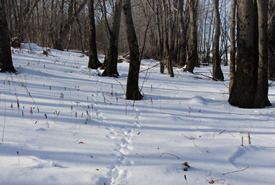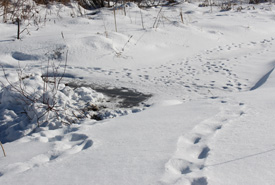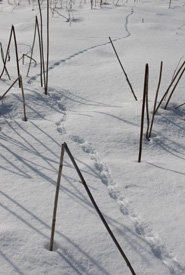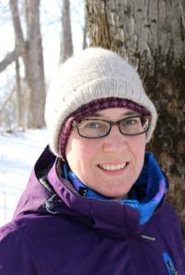Adventures on snowshoe

Tracks in the forest of NCC's Lincoln Wetland Nature Reserve in New Brunswick (Photo by NCC)
I started snowshoeing regularly last winter, and I am hooked! One of the things I love about it is being able to explore areas that are not easily accessible for most of the year. For instance, crossing a large expanse of wetland can be an unpleasant slog filled with biting insects in any other season, but on my snowshoes it is no problem.
One such site close to my home is the Nature Conservancy of Canada’s (NCC’s) Lincoln Wetland Nature Reserve. close to Fredericton, New Brunswick. A trail built on this reserve in 2015 in partnership with the elementary school next door has improved access to the large cattail marsh bordering the St. John River.

Small mammal tracks in the snow (Photo by NCC)
On my recent visit there, I could see the students are also visiting the reserve on snowshoes! The huge old trees by the river are my favourite feature of the Lincoln Wetland Nature Reserve is, but most of the year it is nearly impossible to get across the deep marsh, thick with vegetation as tall as me. In winter however I can snowshoe right over the frozen marsh to visit this magical floodplain forest.

Small mammal tracks in the snow (Photo by NCC)
Another thing I love about snowshoeing is how the wanderings of wildlife are revealed through tell-tale tracks in the snow. After every winter storm the fresh blanket of snow is soon crisscrossed by trails from deer, snowshoe hare, coyote or fox. Even the tiny trails of mice and squirrels are captured in this frozen landscape. These tracks give us a wealth of information about wildlife activity that can be useful for conservation.
NCC’s first land securement projects on the Chignecto Isthmus were guided by the Canadian Wildlife Service's winter tracking observations, showing a concentration of wildlife movement at one location near the New Brunswick–Nova Scotia border. The biologists making these observations were even able to confirm the presence of Canada lynx in the region through tracks in the snow, highlighting the importance of the area as a wildlife corridor.
Snowshoeing is a wonderful way to get outside and explore nature throughout the winter. It requires little equipment and not a lot of skill — if you can walk, then you can snowshoe! If you have been “hibernating” this winter, you still have time to get out on snowshoes. You may, like me, find yourself hoping the snow sticks around!


